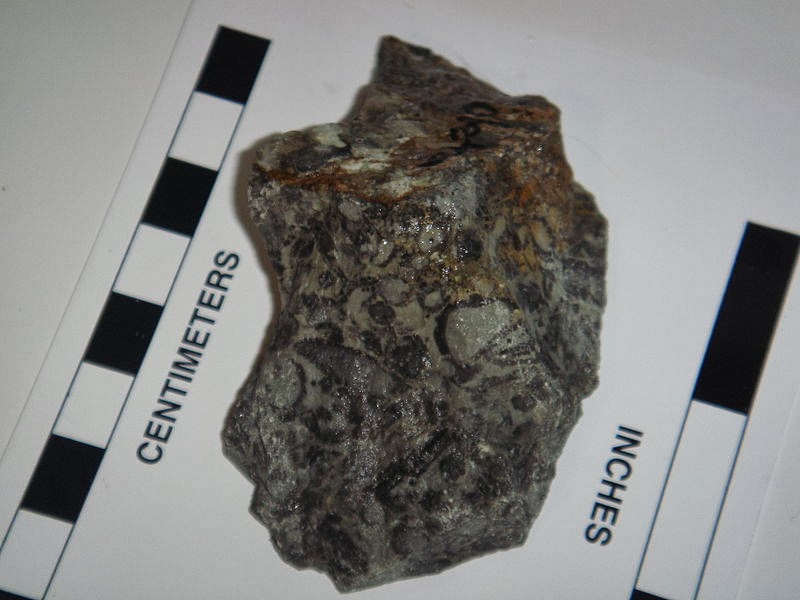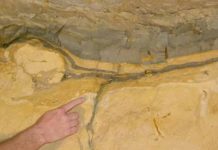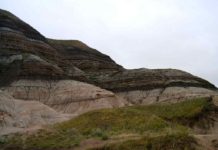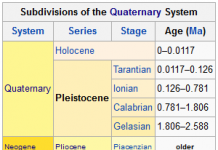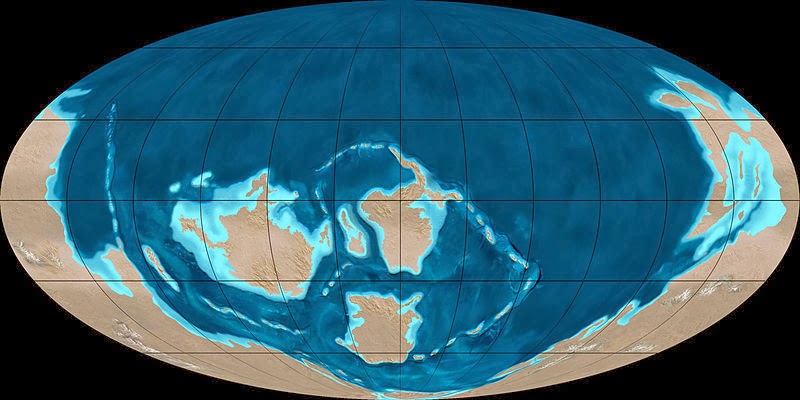
The Cambrian is the first geological period of the Paleozoic Era, lasting from 541.0 ± 1.0 to 485.4 ± 1.9 million years ago (mya) and is succeeded by the Ordovician. Its subdivisions, and indeed its base, are somewhat in flux. The period was established by Adam Sedgwick, who named it after Cambria, the Latin name for Wales, where Britain’s Cambrian rocks are best exposed. The Cambrian is unique in its unusually high proportion of lagerstätten. These are sites of exceptional preservation, where ‘soft’ parts of organisms are preserved as well as their more resistant shells. This means that our understanding of the Cambrian biology surpasses that of some later periods.
The Cambrian Period marked a profound change in life on Earth; prior to the Cambrian, living organisms on the whole were small, unicellular and simple. Complex, multicellular organisms gradually became more common in the millions of years immediately preceding the Cambrian, but it was not until this period that mineralized – hence readily fossilized – organisms became common. The rapid diversification of lifeforms in the Cambrian, known as the Cambrian explosion, produced the first representatives of many modern phyla, representing the evolutionary stems of modern groups of species, such as the molluscs and arthropods. While diverse life forms prospered in the oceans, the land was comparatively barren – with nothing more complex than a microbial soil crust and a few molluscs that emerged to browse on the microbial biofilm Most of the continents were probably dry and rocky due to a lack of vegetation. Shallow seas flanked the margins of several continents created during the breakup of the supercontinent Pannotia. The seas were relatively warm, and polar ice was absent for much of the period.
Stratigraphy
Subdivisions
The Cambrian period follows the Ediacaran and is followed by the Ordovician period. The Cambrian is divided into four epochs or series and ten ages or stages. Currently only two series and five stages are named and have a GSSP.
Because the international stratigraphic subdivision is not yet complete, many local subdivisions are still widely used. In some of these subdivisions the Cambrian is divided into three epochs with locally differing names – the Early Cambrian (Caerfai or Waucoban, 541 ± 0.3 to 509 ± 1.7 mya), Middle Cambrian (St Davids or Albertan, 509 ± 0.3 to 497 ± 1.7 mya) and Furongian (497 ± 0.3 to 485.4 ± 1.7 mya; also known as Late Cambrian, Merioneth or Croixan). Rocks of these epochs are referred to as belonging to the Lower, Middle, or Upper Cambrian.
Trilobite zones allow biostratigraphic correlation in the Cambrian.
Cambrian dating
The time range for the Cambrian has classically been thought to have been from about 542 mya to about 488 mya. The lower boundary of the Cambrian was traditionally set at the earliest appearance of trilobites and also unusual forms known as archeocyathids (literally “ancient cup”) that are thought to be the earliest sponges and also the first non-microbial reef builders.
The end of the period was eventually set at a fairly definite faunal change now identified as an extinction event. Fossil discoveries and radiometric dating in the last quarter of the 20th century have called these dates into question. Date inconsistencies as large as 20 million years are common between authors. Framing dates of ca. 545 to 490 mya were proposed by the International Subcommission on Global Stratigraphy as recently as 2002.
A radiometric date from New Brunswick puts the end of the Lower Cambrian around 511 mya. This leaves 21 mya for the other two series/epochs of the Cambrian.
A more precise date of 542 ± 0.3 mya for the extinction event at the beginning of the Cambrian has recently been submitted. The rationale for this precise dating is interesting in itself as an example of paleological deductive reasoning. Exactly at the Cambrian boundary there is a marked fall in the abundance of carbon-13, a “reverse spike” that paleontologists call an excursion. It is so widespread that it is the best indicator of the position of the Precambrian-Cambrian boundary in stratigraphic sequences of roughly this age. One of the places that this well-established carbon-13 excursion occurs is in Oman. Amthor (2003) describes evidence from Oman that indicates the carbon-isotope excursion relates to a mass extinction: the disappearance of distinctive fossils from the Precambrian coincides exactly with the carbon-13 anomaly. Fortunately, in the Oman sequence, so too does a volcanic ash horizon from which zircons provide a very precise age of 542 ± 0.3 mya (calculated on the decay rate of uranium to lead). This new and precise date tallies with the less precise dates for the carbon-13 anomaly, derived from sequences in Siberia and Namibia.
PaleogeographyPlate reconstructions suggest a global supercontinent, Pannotia, was in the process of breaking up early in the period, with Laurentia (North America), Baltica, and Siberia having separated from the main supercontinent of Gondwana to form isolated land masses. Most continental land was clustered in the Southern Hemisphere at this time, but was gradually drifting north. Large, high-velocity rotational movement of Gondwana appears to have occurred in the Early Cambrian.
With a lack of sea ice – the great glaciers of the Marinoan Snowball Earth were long melted – the sea level was high, which led to large areas of the continents being flooded in warm, shallow seas ideal for thriving life. The sea levels fluctuated somewhat, suggesting there were ‘ice ages’, associated with pulses of expansion and contraction of a south polar ice cap.
ClimateThe Earth was generally cold during the early Cambrian, probably due to the ancient continent of Gondwana covering the South Pole and cutting off polar ocean currents. There were likely polar ice caps and a series of glaciations, as the planet was still recovering from an earlier Snowball Earth. It became warmer towards the end of the period; the glaciers receded and eventually disappeared, and sea levels rose dramatically. This trend would continue into the Ordovician period.FloraAlthough there were a variety of macroscopic marine plants (e.g. Margaretia and Dalyia), no true land plant (embryophyte) fossils are known from the Cambrian. However, biofilms and microbial mats were well developed on Cambrian tidal flats and beaches., and further inland were a variety of lichens, fungi and microbes forming microbial earth ecosystems, comparable with modern soil crust of desert regions, contributing to soil formation.FaunaMost animal life during the Cambrian was aquatic, with trilobites as the dominant life form. The period marked a steep change in the diversity and composition of Earth’s biosphere. The incumbent Ediacaran biota suffered a mass extinction at the base of the period, which corresponds to an increase in the abundance and complexity of burrowing behaviour. This behaviour had a profound and irreversible effect on the substrate which transformed the seabed ecosystems. Before the Cambrian, the sea floor was covered by microbial mats. By the end of the period, burrowing animals had destroyed the mats through bioturbation, and gradually turned the seabeds into what they are today. As a consequence, many of those organisms that were dependent on the mats went extinct, while the other species adapted to the changed environment that now offered new ecological niches. Around the same time there was a seemingly rapid appearance of representatives of all the mineralized phyla except the Bryozoa, which appear in the Lower Ordovician. However, many of these phyla were represented only by stem-group forms; and since mineralized phyla generally have a benthic origin, they may not be a good proxy for (more abundant) non-mineralized phyla.
While the early Cambrian showed such diversification that it has been named the Cambrian Explosion, this changed later in the period, when it was exposed to a sharp drop in biodiversity. About 515 million years ago, the number of species going extinct exceeded the amount of new species appearing. Five million years later, the number of genera had dropped from an earlier peak of about 600 to just 450. Also the speciation rate in many groups was reduced to between a fifth and a third of previous levels. The later half of Cambrian was surprisingly barren; the stromatolites which had been replaced by reef building sponges known as Archaeocyatha, returned once more as the archaeocyathids went extinct. This declining trend did not change before Ordovician.
Some Cambrian organisms ventured onto land, producing the trace fossils Protichnites and Climactichnites. Fossil evidence suggests that euthycarcinoids, an extinct group of arthropods, produced at least some of the Protichnites. Fossils of the maker of Climactichnites have not been found; however, fossil trackways and resting traces suggest a large, slug-like mollusk.
In contrast to later periods, the Cambrian fauna was somewhat restricted; free-floating organisms were rare, with the majority living on or close to the sea floor; and mineralizing animals were rarer than in future periods, in part due to the unfavourable ocean chemistry.
Many modes of preservation are unique to the Cambrian, resulting in an abundance of Lagerstätten.
Note : The above story is based on materials provided by Wikipedia
